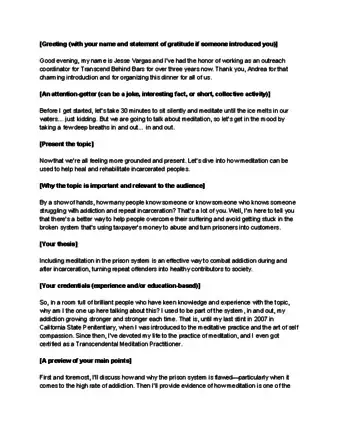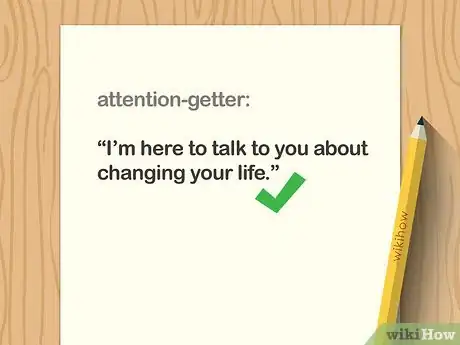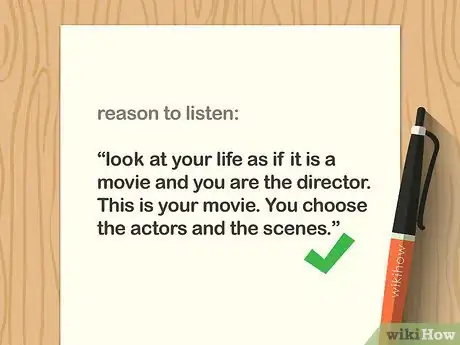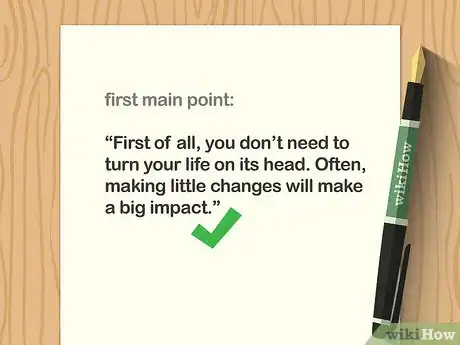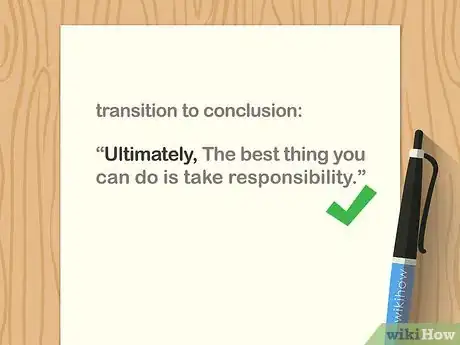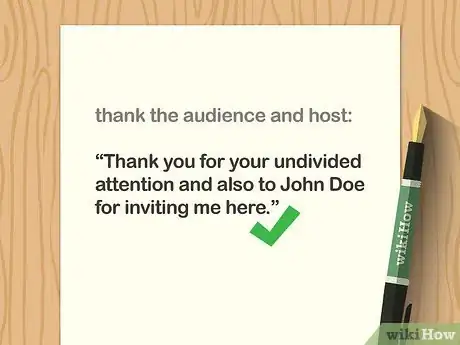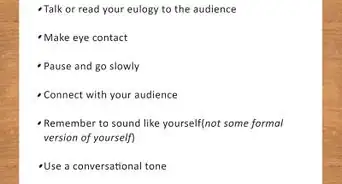This article was co-authored by Emily Listmann, MA and by wikiHow staff writer, Jennifer Mueller, JD. Emily Listmann is a private tutor in San Carlos, California. She has worked as a Social Studies Teacher, Curriculum Coordinator, and an SAT Prep Teacher. She received her MA in Education from the Stanford Graduate School of Education in 2014.
There are 7 references cited in this article, which can be found at the bottom of the page.
wikiHow marks an article as reader-approved once it receives enough positive feedback. This article received 13 testimonials and 80% of readers who voted found it helpful, earning it our reader-approved status.
This article has been viewed 471,808 times.
A speech outline can increase your confidence and help you keep your place so you sound authoritative and in control. As you write your speech outline, focus on how you'll introduce yourself and your topic, the points you'll cover, and the interests of your audience.
Steps
Sample Outline and Writing Help
Crafting Your Introduction
-
1Start with a greeting. The first thing people want to know when you stand to speak is who you are. If someone else has introduced you, take the time to thank them as well as anyone responsible for organizing the event or inviting you to speak.[1]
- Keep in mind you may be nervous when you start your speech. Include this in your outline so you won't forget.
- If there's anything about you that relates you to your audience, or to the group that organized the event, you want to include that in your brief greeting as well – especially if you didn't have the benefit of an introduction from someone else.
- For example, you might say "Good afternoon. I'm Sally Sunshine, and I've been a volunteer with the Springfield Animal Society for five years. I'm honored they've invited me to speak here today about the importance of spaying or neutering your pets."
-
2Open your speech with an attention-getter. You want to grab their attention and hold on to their attention throughout the whole speech. This could be a joke, a personal story, or an interesting observation on your topic that doesn't really fit elsewhere in your speech.[2]
- When choosing your attention-getter, keep your audience in mind. Think about what would grab their attention – not necessarily what you personally find interesting or humorous.
- If you're not sure whether your attention-getter will work, try practicing it in front of friends or family members who are similar in age and interests to the people who will be in the audience when you give your speech.
- For example, if you're giving a speech on spaying and neutering pets to a group of suburban families, you might open with a humorous reference to the Disney movie "101 Dalmatians."
Advertisement -
3Give your audience a reason to listen to your speech. In this part of your introduction, you'll transition from your attention-getting anecdote into the subject matter of the speech itself. This section should only be a sentence or two.[3]
- Briefly explain the importance of the topic or issue you'll be discussing in your speech.
- If your speech is an informative one, explain why the information is important or relevant to your audience.
- For argumentative speeches, explain what might happen if action isn't taken on the issue.
- For example, you might say "Every year, our local animal shelter has to put down 500 unwanted cats and dogs. If all pets were spayed and neutered, it's estimated this number would decrease to under 100."
-
4Present your thesis statement. Your thesis statement, broadly, tells the audience the scope of your speech. The structure and content of this statement will vary based on the type of speech you're giving.[4]
- If you're giving an argumentative speech, your thesis statement will be a statement of the ultimate point you hope to prove through the information and evidence you lay out in your speech.
- For example, the thesis statement for a speech arguing that all pet owners should spay or neuter their pets might be "Our entire community would benefit if all pets were spayed or neutered."
- The thesis statement for a more informative speech will simply summarize the type of information you're going to provide the audience through your speech.
- For a more scientific speech, your thesis statement will reflect the hypothesis of the scientific study you're presenting in your speech.
-
5Establish your credibility. You've made your point, but now you need to let the audience know why they should listen to you. Credibility doesn't necessarily have to be as formal as a specific degree or years of research – it could be a personal story.[5]
- If you're giving a speech for a class in school, your "credibility" may be as simple as the fact that you took the class and researched the topic.
- However, if you have a more personalized interest in the topic of your speech, this is a good time to mention that.
- For an argumentative speech, a personal connection to the subject matter can enhance your credibility. For example, maybe you're giving a speech about local urban housing policy and you became interested in the topic when you learned your family was facing eviction. A personal connection often can mean more to members of your audience than extensive professional experience in the area.
-
6Preview your main points. Now that the audience knows what you're going to talk about, why you're going to talk about it, and why they should listen to you, give them a neat summary of the points you're going to make during your speech.[6]
- There's no hard and fast rule, but speeches typically have three main points. You should list them in your introduction in the order you plan to present them in your speech. The order in which you discuss your points depends on the type of speech you're giving.
- For example, your speech on spaying or neutering pets might address the benefits to the pet first, then the benefit to the pet's family, then the benefit to the community at large. This starts small and moves outward.
- For an argumentative speech, you typically want to lead with your strongest argument and work down in order of strength.
- If you're giving an informative speech based on a historical event, you may want to provide your points chronologically. Other informative speeches may be better served by starting with the broadest point and moving to more narrow points.
- Ultimately, you want to order your points in a way that feels natural to you and will enable you to easily transition from one point to another.
Building the Body of Your Speech
-
1State your first point. The outline of the body of your speech will begin with the first point you intend to make in your speech. Write out a smooth transition from your introduction into the body of your speech.[7]
- Your first point will be a top-level entry on your outline, typically noted by a Roman numeral.
- Beneath that top-level, you will have a number of sub-points which are comments, statistics, or other evidence supporting that point. Depending on how your outline is formatted, these typically will be letters or bullet points.
-
2Present your supporting evidence or arguments. Beneath your first point, you'll list specific evidence or facts you want to mention in your speech that support the point. This could include dates, statistics, or quotes from sources.[8]
- As with the points themselves, with your evidence you typically want to start with the strongest or most important sub-point or piece of evidence and move down. This way, if you start running short on time, you can easily cut the last points without worrying that you're leaving out something important.
- The type of evidence or sub-points you'll want to include will depend on the type of speech you're giving.
- Try to avoid pounding your audience with long series of numbers or statistics – they typically won't retain the information. If you have a significant amount of numerical data or statistics, creating an infographic you can project during your presentation may be more useful.
- Keep in mind that additional personal stories or anecdotes can be particularly effective to get your point across in a speech.
- For example, if your first point in your speech about spaying or neutering pets is that the procedure benefits the pets themselves, you might point out that pets that are spayed or neutered live longer, are at a decreased risk for certain types of cancer, and are generally more healthy than pets who aren't spayed or neutered.
-
3Transition to your next point. After you've finished all the information you want to include for your first point, go back to the top level and find a smooth way to transition from that point to your second point in a sentence or two.[9]
- Avoid over-thinking your transition. It really doesn't need to be incredibly sophisticated. If you can't come up with anything specific, using a simple transitional phrase will work fine.
- For example, you might say "Now that I've discussed how spaying and neutering has a positive effect on your pet's health, I want to move to the effect that spaying and neutering has on your family."
- Some of the most effective transitions turn on a particular word or phrase, such as the word "effect" in the example above.
-
4Repeat the same process for all remaining points. Your outline will look much the same for the remaining two (or more) points you plan to cover in your speech. Start with a top-level outline point that provides a topic sentence of the point, then follow it with three or four-lettered or bulleted sub-points of facts in support.[10]
- When choosing your sub-points or the facts that you want to emphasize in your speech, keep your audience in mind as well as the overall point. Think about what's important to them, or what they potentially would find most surprising or most interesting.
Creating Your Closing
-
1Provide a smooth transition. Now that you've finished the body of your speech, you need an effective transitional sentence that will signal to your audience that you're reaching the end of your speech.[11]
- This transition doesn't need to be fancy – it doesn't even have to be a whole sentence. You can simply say "In conclusion," and then launch into your summary.
-
2Summarize the points you've discussed. Speech coaches often describe a speech's organization as "tell them what you're going to say, say it, then tell them what you said." Start your conclusion by telling your audience what you told them in your speech.[12]
- You don't need to go into detail here – you're just reinforcing what you've already told your audience.
- Make sure you don't introduce any new information in your closing summary.
- For example, you might say "As you've seen, spaying or neutering your pet has substantial benefits not only for you and your pet, but also for the community at large."
-
3Restate your thesis statement. This version of your thesis statement should sound more like a conclusion or an ultimate finding than the hypothesis it may have been in your introduction.[13]
- If your speech went well, you have fully proven your thesis and demonstrated its importance. This statement should relate back to the summary of your points and present a strong statement.
- Particularly for brief speeches, you can even combine your summary of points with your thesis statement in a single sentence that wraps up your speech.
- For example, you might say "Given the benefits to your pet's health, to your family, and to the overall well-being of your community, it is clear that spaying or neutering pets should be a top priority for all pet owners."
-
4Leave your audience something to remember. To close out your speech, think of something on the same note as the attention-getter you used to open your speech. It could be an anecdote or a humorous restatement of the importance of the issue.
- You may want to think of a way to bring the entire speech back around to that story you initially told to grab your audience's attention.
- If you have an argumentative or similar speech, your closing lines typically will include a call to action. Give your audience an example of how important the subject of your speech is, and implore them to act on the information you gave them in a specific way.
- When making a call to action, make sure you include specific details, such as where to go, who to contact, and when to act.
- For example, you might say "For the next week, the Springfield Animal Society will be spaying and neutering pets for free at their clinic on 123 Main Street. Call 555-555-5555 to make an appointment for your furry friend today!"
-
5Thank the audience and anyone who invited you. Thanking the audience for listening to you demonstrates that you respect them and value their time. If you were specifically invited to speak by a particular individual or organization, you should also mention them again.
- Particularly if your speech was longer or if you went over the time allotted, be sure to tell them that you appreciate their time.
- As with your initial greeting, including this in your outline ensures you won't forget it in the moment. That doesn't mean you should try to write something verbatim. Rather, you should focus on your thanks being more off-the-cuff and sincere.
-
6Note time for questions. Speak with the organizers of the event beforehand and find out if you can (or should) invite any questions from the audience about your speech. If you intend to provide time for questions, note this on your outline so you won't forget to mention it at the end of your speech.[14]
- If you want to establish parameters for the questions, be sure to list these in your outline so you can mention them when you announce that you're open for questions.
- Anticipate questions that may be asked dependent on your speech topic. Preemptively answer those questions and include them in your outline.
- You also should note if you only have a specified period of time for questions, or if you're only taking a set number of questions.
Community Q&A
-
QuestionWhat is the best title for speech outline?
 Community AnswerIt all depends on what your speech is about. If your doing a speech about the issues of education, you would want a title such as "What is wrong with our education." Make sure the title corresponds with the speech. If your doing a speech about education, don't title your paper "Jellybeans."
Community AnswerIt all depends on what your speech is about. If your doing a speech about the issues of education, you would want a title such as "What is wrong with our education." Make sure the title corresponds with the speech. If your doing a speech about education, don't title your paper "Jellybeans." -
QuestionHow can teenagers get advice from their elders?
 Community AnswerAsk them the questions directly and show interest in what they are saying.
Community AnswerAsk them the questions directly and show interest in what they are saying. -
QuestionWhere can I find a speech outline on domestic violence?
 Community AnswerTry searching on Google for domestic violence speeches.
Community AnswerTry searching on Google for domestic violence speeches.
References
- ↑ https://canicollege.com/wp-content/uploads/2018/02/USEFUL-PHRASES-AND-STRATEGIES-FOR-PRESENTATIONS.pdf
- ↑ https://www.lamission.edu/learningcenter/docs/asc/worksheets/GeneralWritingResources/Speech%20Outline.pdf
- ↑ https://www.unr.edu/writing-speaking-center/student-resources/writing-speaking-resources/speech-introductions
- ↑ https://owl.purdue.edu/owl/general_writing/the_writing_process/thesis_statement_tips.html
- ↑ https://lewisu.edu/writingcenter/pdf/final-developing-a-speech-outline.pdf
- ↑ https://lewisu.edu/writingcenter/pdf/final-developing-a-speech-outline.pdf
- ↑ https://www.lamission.edu/learningcenter/docs/asc/worksheets/GeneralWritingResources/Speech%20Outline.pdf
- ↑ https://www.unr.edu/writing-speaking-center/student-resources/writing-speaking-resources/speech-evidence
- ↑ https://www.lamission.edu/learningcenter/docs/asc/worksheets/GeneralWritingResources/Speech%20Outline.pdf
- ↑ https://www.lamission.edu/learningcenter/docs/asc/worksheets/GeneralWritingResources/Speech%20Outline.pdf
- ↑ https://open.lib.umn.edu/publicspeaking/chapter/10-2-keeping-your-speech-moving/
- ↑ https://canicollege.com/wp-content/uploads/2018/02/USEFUL-PHRASES-AND-STRATEGIES-FOR-PRESENTATIONS.pdf
- ↑ https://lewisu.edu/writingcenter/pdf/final-developing-a-speech-outline.pdf
- ↑ https://canicollege.com/wp-content/uploads/2018/02/USEFUL-PHRASES-AND-STRATEGIES-FOR-PRESENTATIONS.pdf
About This Article
The best way to write a speech outline is to write the main points of your greeting and introduction in the first section, including your name and what you’ll be talking about. Then, make a second section with bullet points of all the important details you want to mention in the body of your speech. Make sure to include facts and evidence to back your argument up. Finish your outline with a section that summarizes your points concisely. To learn how to keep your audience's attention throughout your speech, keep reading below!
